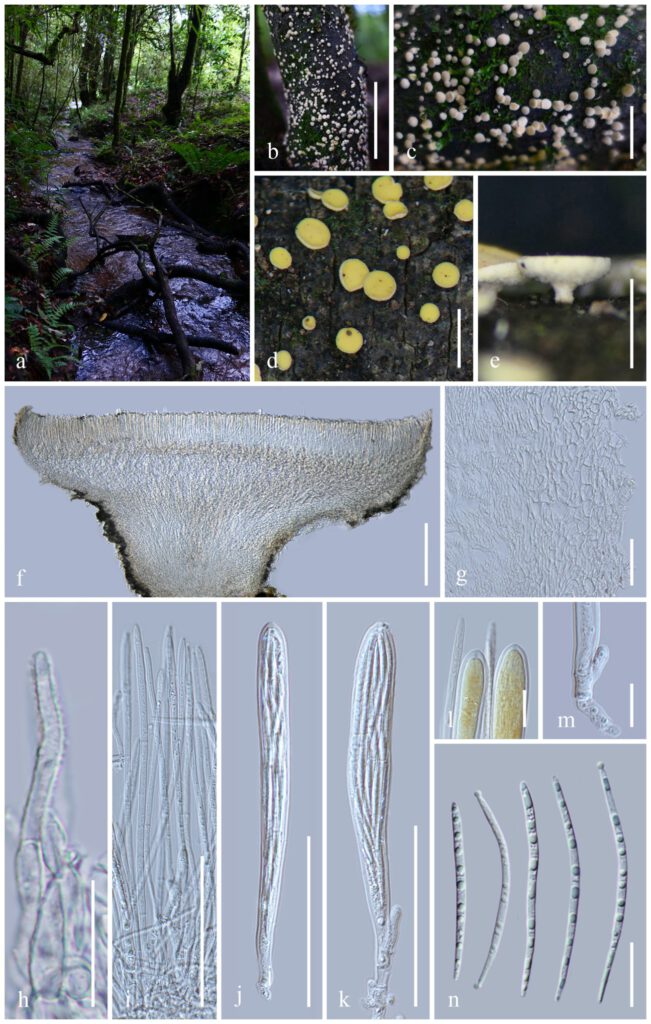Erioscyphella subinsulae H.L. Su, Q. Zhao & K.D. Hyde, sp. nov. Fig 1
Diagnosis – Characterized by yellow hymenium and white receptacle, short, white hairs without apical amorphous or resinous materials, long, filiform ascospores. Similar to the macro- and micromorphology of E. insulae but has different colored discs, larger asci and ascospores.
MycoBank number: MB; Index Fungorum number: IF; Facesoffungi number: FoF 12852;
Etymology – Referring to the similarity with E. insulae.
Growing on bark of a living tree. Sexual morph: Apothecia scattered, superficial, 0.5−1.7 mm in diam, about 0.4−0.8 mm high when dry, discoid to cupulate, shortly stipitate, leathery, externally covered with short, white hairs. Disc concave, surface slightly rough, yellow. Margin flat to slightly involute, white to pale yellow, clothed with white to pale yellow hairs. Receptacle discoid to cupulate, white to pale yellow, clothed with short, white to yellowy hairs entirely. Stipe 0.2−0.3 mm in diameter, 0.1−0.4 mm long when dry, cylindric, solitary, white to pale yellow, clothed with white to yellowy hairs. Hymenium 100–150 µm (x̄ = 120 µm, n = 12), concave, surface slightly rough, light yellowish brown in fresh, yellow in dry. Medullary excipulum 70–180 µm (x̄ = 135 µm, n = 18), thick, hyaline to light brown, thin-walled, smooth, hyaline hyphae of textura intricate, 1.5–3.5µm (x̄ = 2.4 µm, n = 50) in diameter. Ectal excipulum 40–80 µm (x̄ = 57 µm, n = 18) thick, thick-walled, smooth, light brown cells of textura prismatica, 4.5–19.0 × 3.0–12.5 µm (x̄ = 9.8 × 6.0 µm, n = 60). Hairs 30−80 ×2.0−4.0µm (x̄ = 52 × 2.9 µm, n = 30), clavate to cylindric, straight to slightly curved, multiseptate, hyaline, thin-walled, covered with colorless granules totally, obtuse apex, lacking apical amorphous or resinous materials. Paraphyses 85–130 × 2.0–3.0 µm (x̄ = 100 × 2.4 µm, n = 25), longer than asci, filiform, straight, multiseptate, hyaline, colorless, thin-walled, slightly rough, with slightly acute apex. Asci 95–110 × (8.5–) 8.0–10 (–12) µm (x̄ = 100 × 9.3 µm, n = 34), clavate, straight to slightly curved, inoperculate, unitunicate, 8-spored, hyaline, colorless, wall apically thickened, wall laterally relatively thin, slightly rough, with a apical, amyloid pore and tapered ends, croziers absent at the basal septa, blue in MLZ or IKI with and without 3% KOH pretreatment. Ascospores (165/12/3) (43.0–)48.5–74.5(–80.0) ×2.0–3.0 (–3.5) µm, (x̄ = 62.1 × 2.4 µm, Q = 16.6–42.9, Q = 26.34±4.94), fascicled, filiform, 1–3-septate, thin-walled, hyaline, colorless, rough with obtuse, acute ends, some hyaline oil guttules, ends with globules, (1.5–)2.0–3.0(–3.5) µm (x = 2.5 µm, n = 115), subspherical, hyaline, slightly rough. Asexual morph: Unknown.
Known distribution – an evergreen broadleaf forest in the Ailao Mountain, Yunnan, China.
Material examined – China, Yunnan, Ailao Mountains, on the bark of tree, 30 August 2021, H.L. Su, SHL131 (HKAS ***, holotype); ibidem, on the bark of tree, 1 September 2021, H.L. Su, SHL180 (HKAS ***, paratype); ibidem, on the bark of tree, 29 August 2021, H.L. Su, SHL55 (HKAS ***, paratype); ibidem, on the bark of tree, 2 September 2021, H.L. Su, SHL244 (HKAS ***, paratype).
Notes – Erioscyphella subinsulae is closely related to E. insulae in having white receptacles with white hairs, and they form sister groups in the phylogenetic tree (Figure 1). However, E. insulae has cream to pale yellow discs in the dry state, while E. subinsulae has yellow discs. Besides, E. subinsulae has larger asci and ascospores than E. insulae. Furthermore, E. insulae has apical amorphous materials, while E. subinsulae lacks it.

Fig. 1 – Erioscyphella subinsulae (HKAS***, holotype) a Habitat. b, c Fresh apothecia on host surface. d–e Dried apothecia. f Vertical section of an apothecium. g Section of the excipulum. h Hairs. i Paraphyses. j–k Asci. l Apexes of asci. m Base of an ascus. n Ascospores. Scale bars: b = 5 cm, c = 2 cm, d = 2 mm, e = 1 mm, f = 200 µm, g = 50 µm, h = 20 µm, i–k = 50 µm, l–m = 10 µm, n = 20 µm.
